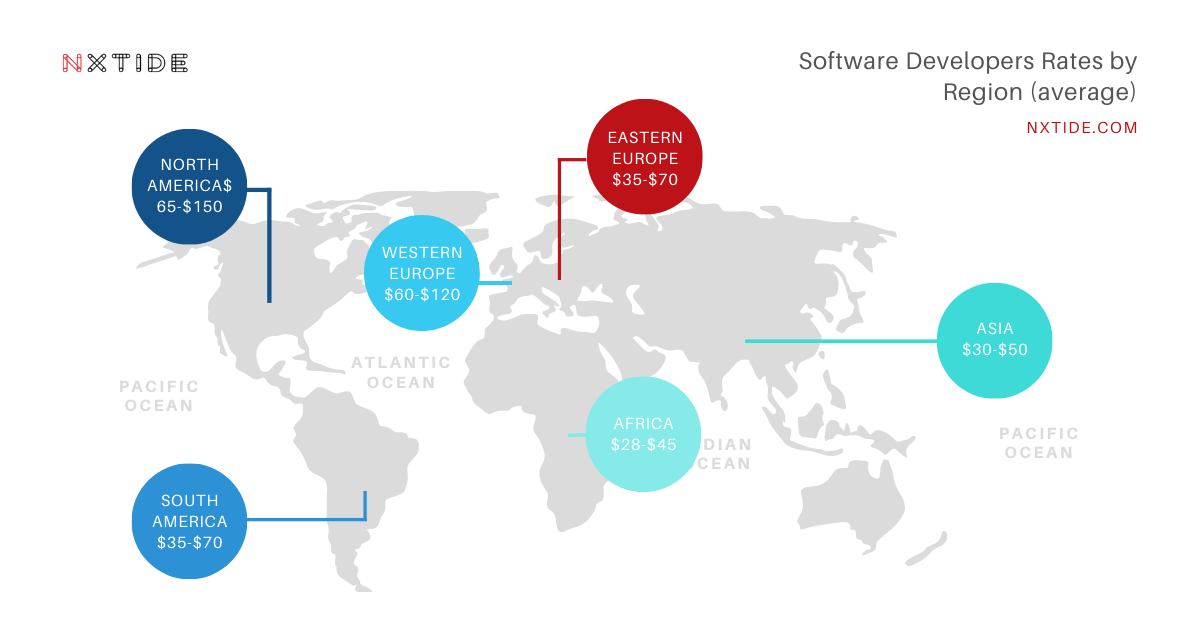Scaling the Software Development Teams – a practical guide from market experts.
Scaling the Software Development Teams – a practical guide from market experts.
Scaling software development team is a sign that your business is progressing, things are going right, and you want to increase capacity or add another field to your scope. You expect that hiring more people or setting up that extra department or two will help you cover new tasks. What can possibly go wrong? You have a well-set process, professionals at your side, and a detailed development strategy. Get more people – and the sky’s the limit, right? No.
As it turns out, scaling software teams often fail, and there are several reasons for that, from communication issues to the attempts to innovate routine processes. But forewarned is forearmed, so let’s pinpoint the main challenges of scaling a development team and outline possible solutions.
How do you know when to scale a software development team?
The first and most important thing you should do before taking this step is to analyze your business needs. Make sure that this move will take your company in the right direction. For example, if you are planning to scale because of the upcoming project deadlines, it might be wiser to consider another way to optimize your resources. In other words, scaling should never be an emergency measure.
Consider these aspects when trying to answer the question of whether your software development team needs scaling: – How fast is your product/service growing? – What is the estimated time and budget for the upcoming project? – Do you foresee any difficulties with attracting new talents? – What is your competition doing? – Is there a potential market for your product/service outside of your current target audience? – Do you have any plans to enter new markets?
If you answered “yes” to most of these questions, then it is time to start thinking about scaling your software development team. The next question is how to do it right and what challenges you might face along the way. Let’s find out.
The challenges of scaling a software development team.
As we have already mentioned, there are several potential risks when expanding a software team (inhouse/nearshore or distributed team). The good news is that all of them can be avoided if you know what to pay attention to.
Here are the main four challenges that we’ve found important to mention:

1) Communication difficulties 2) Loss of corporate culture 3) Inefficient use of resources 4) “Not invented here” syndrome
Let’s take a closer look at each of them.
Communication issues One of the most common issues when scaling a software development team is the lack of communication between team members. It is essential to have an efficient flow of information between all the departments and professionals involved in the project. (especially in the modern distributed team model) Otherwise, you risk facing severe delays or even missing deadlines. It’s even more important when dealing with a distributed software team.
There are several reasons why communication problems might arise: – Lack of a clear understanding of roles and responsibilities; – Misaligned goals and objectives; – The absence of a central repository of information; – Inadequate tools and technologies; – Lack of training for new team members.
All of these factors can lead to a decrease in productivity and, as a result, to project failures. The solution here is pretty straightforward – you need to establish and maintain an open and constant dialogue between all the members of your software development team. Make sure that everyone understands their roles and responsibilities clearly. Define the goals and objectives of the project together and make sure that everyone is on the same page. Use appropriate tools and technologies to facilitate communication and collaboration. And, finally, provide training for new team members to help them understand the company’s culture and values.
Loss of corporate culture Another challenge of scaling a software team is the loss of corporate culture. As your company grows, it becomes more difficult to maintain the same level of cohesion and camaraderie among employees. This is why it is essential to have a strong corporate culture from the very beginning.
A strong corporate culture will help you attract and retain top talent, as well as motivate employees to do their best work and follow the company’s business strategy. It will also make it easier to scale your software development team without losing the identity.
Inefficient use of resources When scaling a software development team, it is essential to use resources efficiently. Otherwise, you risk facing significant financial losses. Make sure that you have a clear understanding of the costs associated with expanding your team. Consider the cost of new hires, training, and benefits, as well as the impact on your current budget.
In addition, pay attention to the way you use your existing team members. Make sure that they are working on tasks that are aligned with their skills and experience. Otherwise, you might end up with an inefficient and unproductive team.
“Not invented here” syndrome The “not invented here” syndrome is a common challenge when scaling software development teams. It occurs when team members refuse to use tools or technologies that are not developed by the company. This can lead to a number of problems, such as: – The loss of time and money; – Inefficient workflows; – A decrease in productivity; – Difficulty adapting to change.
To avoid these problems, it is essential to encourage a culture of openness and collaboration. Make sure that team members are willing to try new things and are open to using tools and technologies developed by other companies.
These are the main challenges of scaling the software development teams. By taking them into account upfront, you can avoid them and make sure that your company grows efficiently

Issues resulting from incorrect software team scaling.
Software development is the process of creating, testing, deploying, and maintaining software applications. It involves a wide range of activities, such as requirements gathering, design, coding, testing, and documentation.
Incorrectly scaled software development teams can lead to a number of problems, such as: – Unnecessary and costly delays; – Devastating software bugs – Incomplete features and/or final product – The drop in Teams’ morale and job exits
All of these problems can have a negative impact on the company, including financial losses and damage to the reputation. Let’s now focus on some principles to avoid these issues.
Things to be done before scaling from a business perspective.
Define the essentials
Start with focusing on the core business essentials. Without a clear understanding of who you are and where you are going, it is next to impossible to build a successful business. Even if you currently face no problems right now it doesn’t mean they will not appear when scaling the company.
Define your company’s mission, vision, and culture. These are the guidelines and foundation for any company uniting the team on the way to achieving goals. They predetermine company potential and appearance. A solid foundation will help you pass the scaling stage with confidence.
Prepare clear company strategy
Having a mission, vision, and culture statements finalized, determine the company’s development strategy. Scaling should be aligned with the strategy. Having no understanding of the “why” you are scaling in the context of the strategy will lead to wrong decisions and losses in the long run.
To track progress and be on the same page with teammates define the performance metrics for every department.
What should be done here?
– Start by creating a three-year company growth plan. We elaborate and synchronize the working processes of all departments from marketing to production.
– Every six months hold an extended C-level meeting to have a candid discussion of how the growth plan is being implemented and make appropriate adjustments if required.
Assign more “Product Owner” roles
Project management in software development is a key to success. With the growing number of projects, it is a good idea to extend the project manager’s responsibilities with the product owner’s ones so that this person becomes a kind of “mini-CEO”. These extra responsibilities include market analysis and finding ways to add product value to customers thus leading to business growth.
The product owner will be the link between the global development of the company and product development.
Define the minimum and maximum team size
Scaling the software teams leads to changes in the structure of your company. Remember that small teams are much easier to manage.
Determine your team’s minimum and maximum size (in our case it should not exceed 7-10 people). If the team is growing you need to split it up and create a new one. Jeff Bezos’ “rule of two pizzas” is a perfect example of how it should work. It states that the team must be large enough to be fed with two pizzas.
Make the teams more independent Small software teams are the foundation of flexible scaling. However, the number of teams should not grow just like that. There is no sense to create a separate team if it is not an independent unit. This will only aggravate communication and team management issues. Ideally, a structured team should be able to deliver project increments being fully independent or as less dependent on other teams as possible. Each team member should be fully committed and responsible for the project outcomes. Small teams make people-focused and committed to providing a better vision of how they contribute to the achievement of a common goal.
Optimiza communication channels The company’s growth and changes made in the organizational structure make it necessary to revise the communication channels. This is especially true now when many employees work remotely. If you have ever worked with remote employees, you know how easily information can be lost. Redesign the communication channels so that each team member receives the information they need promptly with minimal digital noise.
Automate your business process Any manual process is much harder to scale. With the growth of the development team, some tasks become too expensive and at the same time bring minimal effect. Try to automate your business processes as much as possible. This will allow you to distribute your resources most efficiently.
Synchronize the work between teams Previously we discussed the synchronization of departments’ work (business and production). Let’s dig deeper into how product development teams can be synchronized. When scaling product development teams coordination issues may be faced. For instance, one team has already finished its part of the project while the second team is still in progress. As a result, the entire development process slows down because all the parts are interconnected and you can’t go further without the second part being finished. To avoid this, scale the team by the amount of work it can perform. Discuss plans with other team leaders and reallocate resources when necessary.
Hire the right people People are the backbone of any company. All the above-mentioned tips will not have an expected result without the right people. Understanding of ” the right person” can differ greatly. Firstly, it is determined by the culture of the company that you initiated. Do not underestimate the importance of corporate culture. The scaling stage is when the culture is being challenged greatly. For most people, it’s difficult to perceive changes. Sudden changes in the atmosphere of the team can adversely affect its effectiveness. Therefore, it is important to consider the human factor when making decisions about scaling.
Things to be done before scaling from a business perspective.

Plan product infrastructure and architecture.
Sometimes, scaling a team does not lead to proper results due to ill-conceived infrastructure and application architecture. You start developing new functionality and realize that the infrastructure can’t handle the new load. Or the architecture is designed in such a way that certain parts of the application simply stop functioning. Before scaling, think in advance about the design of the scaled product.
Pay close attention to project and product management
With the growing number of teams, the importance of quality project and product management increases. To effectively manage agile teams, use methods that have practically proven their effectiveness.
Some managers believe that the introduction of a Scrum Master in each team is the key to success. However, this is not always the case.
Apply coding best practices
Code quality directly affects the performance of an application. Therefore, in the initial stages, it is critical to create a high-quality MVP. In case of poor code quality, the project will turn into a nightmare at the scaling stage.
To avoid problems, MVP should be created by experienced professionals who are well versed in the best practices of the selected programming languages.
Implement the correct project management system
Project management software should become your best friend during the scaling process. It will help you track the progress of each employee, set deadlines, and monitor compliance with them.
Create a dedicated team to address minor improvements Scaling significantly increases the time spent on minor tweaks. To address this problem a separate team can be formed. Rotate members of this team every two weeks or once per month by gradually adding and removing developers from other teams. Do not change the entire team at once – the transition should be smooth. This will help the rest of the teams focus on the core tasks.
Use pair programming To minify the problem of new team members’ adaptation, use pair programming. The essence of this technique is that a more experienced employee works together with a novice during the first weeks. Working together allows a novice to get used to the company’s processes, tools, and team code writing style faster. Don’t choose the best developers to work with newcomers as they have plenty of core tasks to do. Developers who are a few steps ahead in terms of their knowledge and skills are the best match. People should be comfortable working together; personal qualities and temper are to be taken into consideration when pairing developers as otherwise the approach with not work. Although a senior developer could give more knowledge he is too far from a “novice” status and he may miss out on simple but really important communicational moments. On the other hand, a mentor will better acquire his knowledge.

Some typical mistakes while scaling the software development team.
Division of teams by areas of expertise One of the most common mistakes is dividing teams by areas of expertise. The problem with this approach is that it significantly reduces team flexibility and the ability to quickly change the code.
If you need to make changes to the code, you will have to go through all the levels of coordination between teams. This will lead to a decrease in productivity and an increase in the time required to implement changes by software developers.
A better approach would be to divide teams by functionality. In this case, the team will be able to work on the code much faster and make the necessary changes.
Lack of balance between automation and manual testing
Another mistake that often occurs when scaling software development teams is an imbalance between automation and manual testing.
With the increasing number of features, the amount of manual testing required also increases. However, at the same time, there is a need to automate as much as possible to save time.
The goal should be to find a balance between automation and manual testing. If possible, try to automate as much as possible, but do not forget about manual testing.
Incorrect allocation of resources
Another common mistake when scaling software teams is incorrect resource allocation. With the increasing number of features, the number of software developers required to develop and support them also increases. However, not all tasks can be performed by employees with the same qualifications. Some tasks require more qualified employees, while others can be performed by less qualified employees.
Relying on the personal responsibility of team members
As the team grows, it is important to have clear processes and regulations in place. Don’t rely on the personal responsibility of developers – this will lead to a decrease in productivity.
Focusing only on the development process
Do not focus only on the software development process. It is also important to pay attention to such areas as project and product management, code quality, etc.
Creating a “one size fits all” process
When scaling the team, it is important to remember that not all processes will work for everyone. Therefore, do not try to create a “one size fits all” process. Instead, focus on finding the most effective way to work for each individual team.
Not paying attention to employee morale
When scaling the team, do not forget about the importance of employee morale. If developers are unhappy with their work, it will lead to a decrease in productivity. Therefore, it is important to pay attention to such factors as job satisfaction, workload, company culture, etc.
Too long sprints
When sprint duration is more than two weeks, it becomes difficult to correctly assess the work done and predict the result. Therefore, the team may not have time to make changes if the tasks turn out to be too complex. It is better to use one-week sprints or even two-week sprints in some cases. Experiment with different durations and see what works best for your team.
Unclear task descriptions
It is very important that the tasks to be done during the sprint are well-defined and clear to all team members. Otherwise, there will be a lot of wasted time trying to understand what needs to be done.
Hiring only for hard skills
Agile teams should have not only strong developers but also people who are able to communicate effectively, work in a team, and take responsibility. The best way to assess these qualities is to interview candidates not only during the primary job interview but also during the trial period. Do not forget about the “human factor” when scaling your software development team – it is as important as any other factor in the success of your project.
Wrong assumption that more developers mean faster development
The speed of development does not depend on the number of developers but on how they interact with each other. The main thing is to have clear processes and mutual understanding in the team so that everyone knows their responsibilities. If you have a high-performing team of 10 people, then adding 5 more people will not increase the speed by 50%, as you might expect. Most likely, the speed will decrease as the team will need time to redistribute tasks and get used to working with new people. To avoid this, it is important to have a clear understanding of what needs to be done and how best to do it. The development process should be organized in such a way that each developer knows what needs to be done and how best to do it.
Conclusion
Scaling is a process that is closely related to all the processes happening in the company. It shows how well your company is already formed and reveals problems that are not visible to a small number of employees.
For scaling to go smoothly, you need a solid foundation in the form of a mission, vision, and culture, well-established processes within the company, and a technical base ready for scaling.

We can help you scale your software teams
Over our 7-year company activity we have helped many US and EU companies to successfully build Software Development Teams and Software Development Centers in a variety of locations in Poland.
Interested? – Let’s discuss your case on a call.
Marcin Dziedzic, CEO of Pragmatic Coders and NxTide.
Learn more about our scaling solutions
NxTide is a specialized company focusing on building local, Software Development Teams or larger Software Development Centers in major cities in Poland. We take care of all recruitment and quality control processes making it faster and more cost-effective for you. Here is some more information about our expertise: – Over 7 years experience in creating a variety of software development teams – Over 60 teams and 300 engineers successfully hired and deployed – Several dedicated HR and IT Project Management Teams acting on your behalf.
Please take a closer look at a dedicated and flexible offer we have prepared based on market needs:
1) Software Development Teams: dedicated to clients looking to expand their software development teams or create small remote teams from scratch.
2) Offshore Development Center: dedicated to larger and permanent projects. We’ve implemented the innovative Build Operate Transfer model to make the whole process faster, more efficient, and transparent.
3) Nearshore Software Development Office: dedicated to larger and permanent projects within the same region, continent.

Kraków
Over 0,8M population, 13% of total IT Engineers supply

Warsaw
Over 1,8M population, 24% of total IT Engineers supply

Wrocław
Over 0,7M population, 12% of total IT Engineers supply

Katowice
Over 1,8M population, 9% of total IT Engineers supply

Poznań
Over 0,7M population, 8% of total IT Engineers supply

Łódź
Over 0,7M population, 7% of total IT Engineers supply

Gdańsk
Over 0,6M population, 6% of total IT Engineers supply

Bydgoszcz
Over 0,5M population, 4% of total IT Engineers supply
Other related articles that might interests you:

The Top 20 Tips to Attract, Manage, and Retain Software Developers.
Home The Top 20 Tips to Attract, Manage, and Retain Software Developers. The global tech talent gap.According to the report…

Where to Locate a Software Development Hub, R&D, or IT Center for Your Business?
Home Where to Locate a Software Development Hub, R&D, or IT Center for Your Business? We all are aware that…

The Advantages and Disadvantages of Java Software Development.
Home The Advantages and Disadvantages of Java Software Development. Very few things can remain relevant for over two decades, but…
